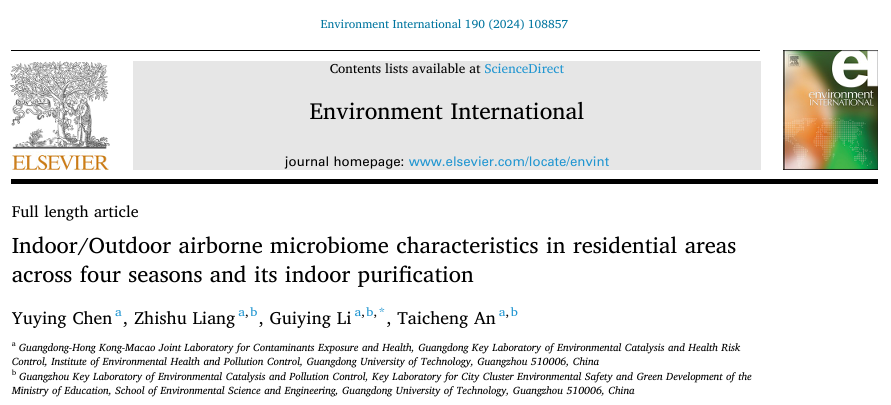近日,广东工业大学环境健康与污染控制研究院、环境科学与工程学院安太成教授团队在广州市典型住宅区域生物气溶胶的分布特征及其室内净化方面取得最新研究进展,研究成果以《Indoor/Outdoor airborne microbiome characteristics in residential areas across four seasons and its indoor purification》(https://doi.org/10.1016/j.envint.2024.108857)为题,于近期发表在Environment International (2024, 190: 108857)期刊上。论文的第一作者为硕士生陈钰莹,通讯作者为李桂英教授。该研究分析了广州市典型住宅区域室内外生物气溶胶的污染特征及季节分布特征,探索了室内生物气溶胶的来源及其存在的健康风险,并在此基础上评估了市售商业化空气净化器对室内生物气溶胶的削减效果。本研究可以为室内微生物气溶胶的污染控制和居住环境的改善提供重要的数据支撑。

文章链接:https://doi.org/10.1016/j.envint.2024.108857
生物气溶胶主要包括病毒、细菌、霉菌孢子、致敏花粉等,这些细小的生物粒子能长时间悬浮在空气中,极易造成健康危害。而人们大部分时间都在室内度过,室内环境更容易聚集生物气溶胶,长期吸入或接触生物气溶胶可能引起人呼吸道疾病或过敏反应。因此本项研究主要选取广州市六处住宅进行为期一年的采样工作,旨在研究典型住宅区域室内和室外生物气溶胶的污染分布、影响因素、健康风险及空气净化器对室内生物气溶胶的削减影响。结果表明:住宅区域生物气溶胶粒径主要是可吸入尺寸(< 4.7 μm),季节之间差异较小(74.61%±2.17%);微生物群落多样性表现出明显的季节差异,夏季丰度较高,但市区内地域差异却不明显,而细菌比真菌更丰富。群落组成分析发现室内和室外环境的优势菌群比较相似,其中Anoxybacillu, Brevibacillus和 Acinetobacter是优势细菌属,Cladosporium, Penicillium 和 Alternaria是优势真菌属。利用热图分析发现空气微生物组对温度和颗粒物 (PM2.5、PM10) 浓度更为敏感。基于斯隆中性群落模型分析,与真菌相比,发现细菌更容易发生随机扩散,空气微生物组在每个季节的室内和室外环境以及两种环境之间均可以随机分布,而室内生物气溶胶可能主要来源于室外。健康风险评估结果表明:室内吸入风险高于室外吸入风险。空气净化器对1.1 ~ 4.7 μm粒径段上的微生物的去除效果较好,对革兰氏阴性菌的去除效果优于革兰氏阳性菌。本研究取得的结果对居民室内生物气溶胶暴露风险评估和污染控制具有非常重要的意义。
图文摘要:

英文摘要:
Bioaerosols are more likely to accumulate in the residential environment, and long-term inhalation may lead to a variety of diseases and allergies. Here, we studied the distribution, influencing factors and diffusion characteristics of indoor and outdoor microbiota pollution in six residential buildings in Guangzhou, southern China over a period of one year. The results showed that the particle sizes of bioaerosol were mainly in the range of inhalable particle size (<4.7 μm) with a small difference among four seasons (74.61 % ± 2.17 %). The microbial communities showed obvious seasonal differences with high abundance in summer, but no obvious geographical differences. Among them, the bacteria were more abundant than the fungi. The dominant microbes in indoor and outdoor environments were similar, with Anoxybacillu, Brevibacillus and Acinetobacter as the dominant bacteria, and Cladosporium, Penicillium and Alternaria as the dominant fungi. The airborne microbiomes were more sensitive to temperature and particulate matter (PM2.5 , PM10) concentrations. Based on the Sloan neutral model, bacteria were more prone to random diffusion than fungi, and the airborne microbiome can be randomly distributed in indoor and outdoor environments and between the two environments in each season. Bioaerosol in indoor was mainly from outdoor. The health risk evaluation showed that the indoor inhalation risks were higher than those outdoor. The air purifier had a better removal efficiency on 1.1–4.7μm microorganisms, and the removal efficiency on Gram-negative bacteria was better than that on Gram-positive bacteria. This study is of great significance for the risk assessment and control of residential indoor bioaerosol exposure.
项目资助:本研究受到国家重点研发项目(2023YFC3708202和2023YFC3708204)、 国家自然科学基金项目(U1901210, 42177410和42130611)和广东省科协青年科技人才培养计划项目(2022QNRC23)的联合资助。